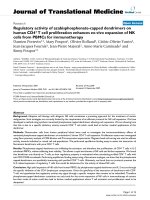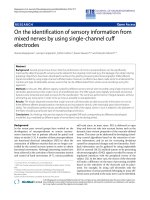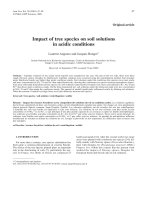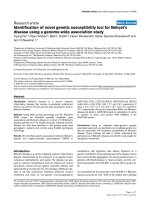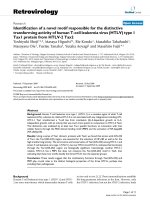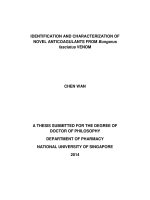Isolation and identification of Bacillus species from soil for phosphate, potassium solubilisation and amylase production
Bạn đang xem bản rút gọn của tài liệu. Xem và tải ngay bản đầy đủ của tài liệu tại đây (313.82 KB, 12 trang )
Int.J.Curr.Microbiol.App.Sci (2020) 9(5): 415-426
International Journal of Current Microbiology and Applied Sciences
ISSN: 2319-7706 Volume 9 Number 5 (2020)
Journal homepage:
Original Research Article
/>
Isolation and Identification of Bacillus Species from Soil for Phosphate,
Potassium Solubilisation and Amylase Production
Shambhavi1, Ravindra Kumar1*, Akash Tomar1, Purushottam1,
Jitender Singh1 and Shishu Pal Singh2
1
College of Biotechnology, Sardar Vallabhbhai Patel University of Agriculture and
Technology, Meerut, Uttar Pradesh, India-250110
2
College of Agriculture, Sardar Vallabhbhai Patel University of Agriculture and Technology,
Meerut, Uttar Pradesh, India-250110
*Corresponding author
ABSTRACT
Keywords
solubilisation,
nitrogen
fixation, PGPR,
Bacillus sp. and
Pseudomonas sp
Article Info
Accepted:
05 April 2020
Available Online:
10 May 2020
In the present study ten different Bacillus isolates were isolated from various soil samples and their
identification was performed on the basis of Gram staining, colony morphology and biochemical
tests. Gram positive rod shaped bacteria showing large, circular, opaque colonies having white or
greyish white appearance were preserved on Nutrient agar slants for further identification. All
isolates showed positive results for Catalase, Urease, Oxidase and motility biochemical tests. For
other biochemical tests such as Citrate utilization, Vogues Proskauer, Nitrate reduction, Triple sugar
iron Agar test, mixed results were obtained. Phosphate solubilisation and Potassium solubilisation
activities of different isolates was performed. Out of ten isolates, none of the isolates solubilised
phosphate on Pikovskaya’s agar medium at 30°C after 15 days of incubation. Potassium solubilising
activity was shown by two isolates (Sample code 3 and 9) out of ten. Among these two isolates,
Sample code 3 showed highest potassium solubilisation and the clear zone on Aleksandrov agar
medium was 9 mm and that of Sample Code 9 was 5 mm, after 10 days of incubation at 30°C.
Further, the isolates were screened for the production of amylase and its assay has been performed.
Seven isolates displayed zone of clearance in starch hydrolysis test except Sample code 5, 7 and 8.
Sample code 5, 7 and 8 isolates gave negative results for TSI test also. The isolates were subjected to
amylase activity test. Maximum amylase was produced by Sample code 9 at 3.90 mg/ml after 24
hours of incubation. Sample code 10 showed least amylase production at 0.86 mg/ml.
Soil microorganisms play a vital role in the
evolution of agriculturally useful soil
conditions and in stimulating plant growth
(Compant, 2005).
Introduction
The soil acts as a reservoir for millions of
microorganisms, of which approximately
more than 85% are beneficial for plant life.
Thus soil is a resilient eco system and soil
microorganisms provide precious life to soil
ecosystems catering to plant growth.
Soil bacteria having beneficial effect on plant
health are commonly referred to plant growth
promoting rhizobacteria (PGPR).
415
Int.J.Curr.Microbiol.App.Sci (2020) 9(5): 415-426
PGPR promote plant growth directly and
indirectly but the specific mechanisms
involved have not all been well characterized
(Glick, 1995).
The rhizospheric soil is
dominated by the diverse bacterial
communities (Buee et al., 2009; Farina et al.,
2012; Bouizgarne et al., 2014; Mirza et al.,
2014; Tahir et al., 2015). Bacillus species are
considered to be the safe microorganisms that
hold remarkable abilities for synthesizing a
vast array of beneficial substances (Stein,
2005). Bacillus species have potent plant
growth promoting traits such as IAA
production, phosphate solubilisation, nitrogen
fixation and bio control attributes like
production of HCN, siderophore, hydrolytic
enzymes and antibiotics have been isolated
from soybean (Senthilkumar et al., 2009).
Bacillus species are Gram positive, endospore
– forming, chemo heterotrophic rod shaped
bacteria which are usually motile with
peritrichous flagella; they are aerobic or
facultative anaerobic and catalase positive
(Waites et al., 2008). Among all
PGPBs, Bacillus spp. has been reported to
have tolerance towards the adverse conditions
and, therefore, the most potential candidate
used for enhancing the soil fertility and crop
health (Vivas et al., 2003). Bacillus spp. is
also known to enhance of macroand micronutrients in the soil and their uptake
by host plant (Stefan et al., 2013).
soil. However, under such conditions
microorganisms offer a biological rescue
capability of solubilising the insoluble
inorganic phosphorus of soil. Phosphate
solubilising
microorganisms
(PSM)
particularly those belonging to the genera
Bacillus sp. and Pseudomonas sp. and many
others possess the ability to bring insoluble
phosphates in soil into soluble forms by
secreting organic acids such as formic, acetic,
propionic lactic, glycolic, fumaric and
succinic acids (Rashid et al., 2004; Ivanova et
al., 2006). Phosphate solubilising bacteria
(PSB)
mobilize
insoluble
inorganic
phosphates from their surrounding soil
mineral matrix to the bulk soil where they can
be absorbed by plant roots for their growth
and development (Pe’rez et al., 2007).
Potassium is the third important plant
nutrient. Its plays a key role in the growth,
metabolism, and development of plants.
Without adequate supply of potassium, the
plants will have poorly developed roots, grow
slowly, produce small seeds and have lower
yields (McAfee, 2008; White and Karley,
2010) and the increased susceptibility to
diseases (Amtmann et al., 2008; Armengaud
et al., 2010) and pest (Amtmann et al., 2006;
Troufflard et al., 2010). A wide range of
KSMs namely Bacillus mucilaginosus,
Bacillus edaphicus, Bacillus circulans,
Paenibacillus
spp.,
Acidothiobacillus
ferrooxidans, Pseudomonas, Burkholderia
(Sheng et al., 2008; Lian et al., 2002; Rajawat
et al., 2012; Liu et al., 2012; Basak and
Biswas, 2012; Singh et al., 2010) have been
reported to release potassium in accessible
form from K-bearing minerals in soils.
There are several minerals containing
essential elements in the soil, but most
important minerals are nitrogen (N),
phosphorus (P), and potassium (K) (McAfee,
2008; White and Karley, 2010). Phosphorus is
a major essential macro element required for
plants to growth and development (Singh et
al., 1994). Most of the essential plant
nutrients, including phosphorus, remain in
insoluble form in soil (Abd-Alla, 1994; Yadav
et al., 1997). Chemical phosphate fertilizers
are only meagrely soluble under the
conditions in which they are applied to the
Enzymes are protein molecules, which are
necessary for life. Amylases are enzymes that
break down complex carbohydrates. There are
different sources to produce amylases. Plants,
animals and microbes can produce amylases
(Aiyer, 2004).
416
Int.J.Curr.Microbiol.App.Sci (2020) 9(5): 415-426
Amylases
are
used
in
various
biotechnological
processes
including
renewable
energy,
pharmaceuticals,
saccharification or liquefication of starch,
detergents industries, warp sizing of textiles,
fibers, paper industries, food staffs, baking,
classification of haze formed in beer or fruit
juices and for pre-treatment of animal feed to
improve digestibility (Behal et al., 2006).
Microorganisms produce different kinds of
industrial enzymes. Because of their
biochemical diversity and the ease with
environmental and genetic manipulation, they
have replaced enzymes, which traditionally
have been isolated from complex eukaryotes
(Pandey et al., 2000). Many microorganisms
are able to produce amylases including
Bacillus spp., Lactobacillus, Escherichia,
Proteus, Strepotmyces sp., Pseudomonas sp.
etc. For production of amylase for industrial
use, isolation and characterization of new
promising strains is a continuous process
(Vaidya et al., 2015).
150 ml sterile distilled water and heat treated
at (80°C) for 15 minutes. After that 0.1 ml of
soil suspension was spread over pre sterilized
nutrient agar plates. The inoculated plates
were incubated at 30°C for 24-48 hours. The
plates were examined after incubation period
for rough and abundant colonies with waxy
growth (1-4mm diameter) and irregular
spreading edge. Suspected colonies were
stained by Gram staining method. The Gram
positive bacilli were maintained on Nutrient
agar slants for additional identification tests
(Kumar et al., 2012; Amin et al., 2015).
Biochemical characterization
The isolates were subjected to different
biochemical parameters.
Citrate utilization test
Citrate Utilization test is used to detect the
ability of an organism to utilize sodium citrate
as a sole source of carbon and ammonium salt
as a sole source of nitrogen. Simmon’s citrate
medium was prepared, sterilized and the
slants were streaked back and forth with a
light inoculum picked from the centre of a
well-isolated colony. Test tubes were
incubated aerobically at 35 to 37°C for up to
4-7 days. A colour change was observed from
green
to
blue
along
the
slant.
( (Claus, 1989 and Jawetz, E., et
al., 1989)
Materials and Methods
The present investigation was carried out to
isolate native Bacillus isolates from different
soil samples to carry out phosphate,
potassium solubilisation and amylase
production.
Collection of samples
Ten soil samples were collected from various
fields, gardens of Sardar Vallabhbhai Patel
University of Agriculture and Technology,
Meerut and Bafawat village of Meerut
district. Soil samples were collected in the
sterile plastic pouches and brought to the
laboratory under normal temperature for
microbiological analysis.
Vogues- proskauer test
The test depends on the digestion of glucose
to acetyl
methyl
carbinol
(acetoin)
MacFaddin,
J.F.,(1980)
( />%93Proskauer_test). MR/VP broth was
inoculated with a pure culture of the test
organism.
Isolation of Bacillus isolates
Fifty gram soil samples were transferred to
417
Int.J.Curr.Microbiol.App.Sci (2020) 9(5): 415-426
Test tubes were incubated for 24 hours at
35oC. At the end of this time, 1 ml of broth
was transferred to clean test tube. Five
percent alpha naphthol (0.6 ml) followed by
0.2 mL of 40% KOH was added to each test
tube. Tubes were shaked gently to expose the
medium to atmospheric oxygen and were
allowed to remain undisturbed for 10 to 15
minutes. Change of colour was observed
( />
Nitrate reduction test
Nitrate reduction test is used to detect the
ability
to
produce nitrate
reductase
enzyme that hydrolyze nitrate (NO3–) to
nitrite (NO2–). Nitrate broth was prepared,
sterilized and inoculated with a heavy growth
of test organism using aseptic technique.
Tubes were incubated at 37°C for 24 to 48
hours One ml of sulfanilic acid reagent and 45 drops of α-naphthylamine was added to
each test tube. Change of colour was observed
(Conn
and
Breed,
1919).
( />
Motility test
SIM medium was prepared, sterilized and
poured in test tubes. Using an inoculating
needle, the centre of SIM medium was
stabbed to within the bottom half of the tube
from pure 18-24 hour culture. Tubes were
incubated at 33-37°C for 18-24 hours.
Triple sugar iron test
Triple sugar iron agar test is used to
determine whether microorganisms utilize
glucose and lactose or sucrose fermentatively
and produce H2S. Triple sugar iron medium
was prepared, sterilized and slants were made.
A well isolated colony was touched with a
sterile stabbing loop.
This media has a very soft consistency that
allows motile bacteria to migrate readily
through them causing cloudiness in the
stabbed area (Harley, 2005; MacFaddin 2000;
Baron, E., and S. Finegold, 1990)
( />
TSI slants were inoculated by first stabbing
through the centre of the medium to the
bottom of the tube and then streak was done
on the surface of the slant. Tubes were
incubated at 35°C in for 18 to 24 hours.
Reaction
was
observed
( />(Tille, 2014)
Catalase test
Catalase is an enzyme, which is produced by
microorganisms that live in oxygenated
environments to neutralize toxic forms of
oxygen metabolites; H2O2. A small amount of
bacterial colony was transferred to a surface
of clean, dry glass slide using a loop.
Urease test
A drop of 3% H2O2 (as given in appendix B3)
was put on to the slide and mix. A positive
result is the rapid evolution of oxygen (within
5-10 sec.) as evidenced by bubbling (Facklam
and
Elliott
1995)
( />
Urease test is used to determine the ability of
an organism to split urea, through the
production of the enzyme urease. Urea broth
was prepared, sterilized and poured into test
tubes. Broth was inoculated with the
inoculation loop containing loop full of
organism.
418
Int.J.Curr.Microbiol.App.Sci (2020) 9(5): 415-426
Incubate for 24-48 hours at 37°C. Change in
colour was observed (Bailey, W. R., and E. G.
Scott,
1974
and
Christensen.
1946)( />&sim=214&cnt=2).
Starch agar medium was prepared and poured
into the Petri-plates (Shaw et al., 1995). After
solidification of plates, bacterial colonies
were streaked in straight lines on the plates
with the help of sterilized inoculating loop.
Oxidase test
Inoculated plates were incubated in inverted
position at 30˚C for 24-48 hours. After
incubation, bacterial colonies were visible on
the plates and a clear zone was visible near
the bacterial growth. The plates were flooded
with Gram’s iodine solution. No dark blue
colour was seen around the bacterial colonies
showing zone of degradation (Gupta et al.,
2003).
The oxidase test is used to identify bacteria
that produce cytochrome c oxidase, an
enzyme of the bacterial electron transport
chain
( />A strip of Whatman’s No. 1 filter paper was
soaked in a freshly prepared 1% solution of
tertramethyl-p-phenylene-diamine
dihydrochloride. A strip was laid in a petri
dish and moistened with distilled water. The
colony to be tested was picked up and
smeared over the moist area. A positive
reaction was indicated by an intense deeppurple hue, appearing within 5-10 seconds
(Isenberg, 2004; MacFaddin, 2000; Cowan
and Steel, 1993)
Amylase production
Enzyme production medium (g/l) Starch
10.0g, Peptone 5.0g, Ammonium sulphate
2.0g, Potassium di hydrogen phosphate 1.0g,
Di potassium hydrogen phosphate 2.0g,
Magnesium sulphate 0.5g, Potassium chloride
0.5g was prepared and sterilized. Twenty
millilitre of medium was taken in a 100ml
conical flask.
These flasks were inoculated with bacterial
culture. Inoculated medium was incubated at
37°C in shaker incubator for 24 hr at 120rpm.
At the end of fermentation period, the culture
medium was centrifuged at 10,000 rpm for 15
min to obtain crude extract as supernatant,
which served as enzyme source (Vaidya et al.,
2015; Singh et al., 2016).
Analysis of phosphorus solubilising activity
For Qualitative analysis isolates were spot
inoculated at the centre of Pikovskaya’s agar
(Pikovskaya, 1948) plates aseptically. Plates
were incubated at 37°C for 5-7 days.
Diameter of clearance zone was measured.
Analysis of potassium solubilising activity
Amylase assay
For Qualitative analysis isolates were spot
inoculated at the centre of Aleksandrov agar
(Hu et al., 2006) plates aseptically. Plates
were incubated at 30°C for 7 days. Diameter
of clearance zone was measured.
One percent starch (1ml), 2 ml of 0.1 M
phosphate buffer (pH 6.5) and 0.5 ml of
enzyme were incubated for 15 min at room
temperature. One ml of DNS reagent was
added and the solution was kept in boiling
water bath for 10 min. Solution was diluted
by adding 8 ml of distilled water (Bernfeld,
1955).
Screening for amylase activity (starch
hydrolysis test)
419
Int.J.Curr.Microbiol.App.Sci (2020) 9(5): 415-426
The absorbance was measured at 540 nm
against blank prepared as above without
enzyme and incubation. One unit of αamylase activity was defined as the amount of
enzyme that liberates 1 µmole of reducing
sugars (maltose equivalents) per minute under
the assay conditions (Miller, 1959).
The rods were of different sizes. Sample code
2, 3, 4, 6 appeared to be small rods, Sample
code 1 and 10 were medium rods and Sample
code 5, 7, 8, 9 were large rods. Kannahi et al.,
(2015) used serial dilution and plating method
for the isolation of bacterial colonies. These
colonies were identified by gram staining and
biochemical test. Bacteria belonging to the
genera Bacillus, Pseudomonas, Serratia,
Enterobacter, etc., are reported to solubilise
the insoluble phosphatic compounds and aid
in plant growth.
Standard graph for maltose
Standard maltose solution (10mg/ml) solution
was prepared. Five separate test tubes were
taken and 0.2, 0.4, 0.6, 0.8 and 1 ml standard
maltose solution was pipette out. A test tube
containing blank solution was also prepared.
The volume was maintained up to 2 ml in
each test tube including blank with distilled
water. One ml DNS reagent was added to
each test tube and test tubes were covered
with aluminium foil. The test tubes were kept
on boiling water bath for 5 minutes at 37°C.
The test tubes were allowed to cool and 9 ml
distilled water was added to each test tube and
mixed well. Intensity of dark yellowish
orange colour was measured as absorbance or
OD in a spectrophotometer at 540 nm. A
graph was plotted with the concentration of
maltose on X axis Vs OD at 540 nm on Y axis
( />=163&cnt=2).
Biochemical analysis revealed that the all ten
isolates showed positives results for Catalase,
Motility, Urease and Oxidase tests. For other
biochemical tests, mixed results were found,
some being positive and some negative (Table
II).
Out of 10 isolates, none of the isolates
solubilised phosphate on Pikovskaya’s agar
medium, hence showed negative results.
However, Kumar et al., (2012) found that a
spore forming Bacillus sp. BPR7 strain was
the best solubilizer of inorganic phosphates
due to the production of organic acids.
Similar results were obtained by Tripti et al.,
(2012) that an isolated bacterial strain S2
(Bacillus sp.) was significant phosphate
solubilizer. Karpagam et al., (2014) observed
that isolate psm2 (Bacillus sp.) (0.786 U/ml)
showed highest percent P solubilisation when
compared to other isolates.
Results and Discussion
Bacillus isolated from ten different soil
samples, were opaque, moist, white or greyish
white in colour.
The colony elevation
appeared to be flat. The colony morphology
study showed that the colony on nutrient agar
medium formed circular or irregular edges.
The colonies were of different sizes, some
small, some medium and some large colonies
were found. The results for various isolates
have been summarized in Table I. After Gram
staining and microscopy, it was observed that
all Bacillus isolates were Gram positive as
purple colour rods were observed at 40X.
Two isolates namely 3 and 9 solubilised
potassium on Aleksandrov agar medium.
Potassium solubilising activities of these 2
isolates is shown in Table III. Rest of the
isolates showed negative result. Similar study
was carried out by Anjanadevi et al., (2015)
in which 36 different bacteria were isolated
from rocks of a major hill station at Ponmudi
in Thiruvananthapuram, Kerala, India. A
comprehensive
characterization
of
K
solubilisation from feldspar was achieved
420
Int.J.Curr.Microbiol.App.Sci (2020) 9(5): 415-426
with these isolates which indicated that the K
solubilising efficiency increases with decrease
in pH and increase in viscosity and viable cell
count. Based on the level of K solubilisation,
two potent isolates were selected and
identified as Bacillus subtilis ANctcri3 and
Bacillus megaterium ANctcri7. The Bacillus
isolates were also screened for amylase
activity on Starch hydrolysis test. Out of ten
isolates, seven bacteria showed the zone of
clearance on starch agar media except 5, 7
and 8. After amylase production it was
observed that Sample code 9 produced 3.90
mg/ml of amylase.
Similar study was
performed by Singh et al., (2016) in which
Out of ten isolates, five bacteria showed zone
of clearance on starch agar media and among
five, Bacillus sp. B3 showed the maximum
zone of clearance on the starch agar medium
i.e. 8mm. So, B3 isolate was selected for the
further study of amylase activity.
Isolated Bacillus sp. B3 was found to be
effective in releasing high amount of reducing
sugars. The amylase activity decreases from
0.981 to 0.215 U/ml as the incubation time
increase from 24 to 72 hours at 35 ±2°C.
Vaidya et al., (2015) isolated α-amylase
producing bacterial strains from the soil of
potato dump sites.
Table.1 Bacillus isolates with different Characteristics on Nutrient agar medium
Sample code
Characterist
ics
Form
1
2
3
4
5
6
7
8
9
10
Circular
Circular
Irregular
Irregular
Circular
Circular
Circular
Circular
Circular
Circular
Elevation
Flat
Flat
Flat
Flat
Flat
Flat
Flat
Flat
Flat
Flat
Size
Medium
Large
Large
Large
Large
Medium
Medium
Medium
Medium
Small
Opacity
Opaque
Opaque
Opaque
Opaque
Opaque
Opaque
Opaque
Opaque
Opaque
Opaque
Colour
White
White
White
White
Moist
Moist
Moist
Greyish
White
Moist
White
Moist
Greyish
White
Moist
White
Surface
Greyish
White
Moist
Greyish
white
Moist
Moist
Moist
Table.2 Biochemical characteristics of different Bacillus isolates studied in the present study
4
Isolates
5
6
7
8
9
10
+
+
+
+
+
-
+
+
+
-
-
+
+
-
+
-
+
+
+
+
+
+
+
+
+
+
+
+
+
+
+
+
+
+
+
+
+
+
+
+
+
+
+
+
+
+
+
+
+
+
+
+
+
+
+
+
+
+
+
+
+
+
+
+
+
+
+
+
+
+
Biochemical Tests
1
2
3
Citrate utilization
+
-
Vogues Proskauer
+
Motility
Catalase
Nitrate reduction
TSI
Urease
Oxidase
421
Int.J.Curr.Microbiol.App.Sci (2020) 9(5): 415-426
Table.3 Potassium solubilising activities of different Bacillus isolates
Sample code
3
9
After 7 days
After 10 days
Colony
measurement
(d) (in mm)
Zone
measurement
(D) (in mm)
(D –d)
Colony
measurement
(d) (in mm)
Zone
measurement
(D) (in mm)
(D –d)
11
7
19
11
8
4
11
7
20
12
9
5
Table.4 Concentration of Amylase produced by different Bacillus isolates
Sample Code
1
2
3
4
5
6
7
8
9
10
Concentration (mg/ml)
3.49
2.68
0.95
2.44
2.65
1.62
2.16
1.90
3.90
0.86
Figure.1 Comparison of amylase produced by different isolates of Bacillus on Enzyme
production medium
422
Int.J.Curr.Microbiol.App.Sci (2020) 9(5): 415-426
A total of 18 bacterial strains were isolated.
Among which 5 strains gave zone of
clearance with iodine solution on starch
hydrolysis test. These were further selected
and quantified. Amongst these, the isolate
showing maximum absorbance was further
optimized and characterized and found to
belong to the genus Bacillus.
Out of ten, seven isolates showed visible clear
zone when streaked on starch agar plates after
24-48 hours of incubation except sample code
5, 7 & 8. Sample code 5, 7 & 8 were the only
isolates which gave negative results for TSI
Test. The isolates were further analyzed for
amylase production and its assay. The
concentration of amylase produced was
between 0.86 mg/ml - 3.90 mg/ml for the
various Bacillus isolates.
In this study, Comparative analysis of
amylase produced by different isolates of
Bacillus is shown in Figure I. Concentration
of amylase produced by Bacillus isolates is
given in Table IV.
References
Abd-Alla, M.H. (1994). Phosphatases and the
utilization of organic phosphorus by
Rhizobium leguminosarum biovar viceae.
Lett. Appl. Microbiol, 18: 294-296.
Aiyer, P.V. (2004). Effect of C: N ratio on alpha
amylase
production
by
Bacillus
licheniformis SPT 27. Afr. J. Biotechnol, 3:
519-522.
Amin, M., Rakhisi, Z., Ahmady, A.Z. (2015).
Isolation and Identification of Bacillus
Species From Soil and Evaluation of Their
Antibacterial Properties. Avicenna J Clin
Microb Infec., 2(1): e23233.
Amtmann, A., Hammond, J.P, Armengaud, P.,
White, P.J. (2006). Nutrient sensing and
signaling in plants: potassium and
phosphorus. Adv Bot Res, 43: 209–257.
Amtmann, A., Troufflard, S., Armengaud, P.
(2008). The effect of potassium nutrition on
pest and disease resistance in plants.
Physiol Plant, 133: 682–691.
Anjanadevi, I.P., John, N.S., John, K.S., Jeeva,
M.L., Misra, R.S. (2015). Rock inhabiting
potassium solubilising bacteria from
Kerala,
India:
characterization
and
possibility in chemical K fertilizer
substitution.
/>Armengaud, P., Breitling, R., Amtmann, A.
(2010). Coronatine intensive 1 (COII)
mediates transcriptional responses of
Arabidopsis thaliana to external potassium
supply. Mol Plant, 3(2): 390–405.
Bailey, W. R., and E. G. Scott. (1974) Diagnostic
microbiology, 4th ed. Mosby, St. Louis,
MO.
Baron, E., and S. Finegold. Bailey and Scott’s
This research was undertaken to isolate ten
Bacillus isolates from different soil samples
to test their ability to solubilise phosphate and
potassium. Screening for the production of
amylase and its assay has also been
performed. Colonies of the Bacillus isolates
appeared to be circular, flat, round and large
on Nutrient agar plates. Few medium and
small sized colonies were also observed. The
length of the colonies varied from 1mm to
12mm. Gram staining revealed that all
isolates were Gram positive rods. However,
the difference in the length of the rods was
visible when microscopy was performed.
After Biochemical analysis, it can be
summarized that all Bacillus isolates showed
positive results for Catalase, Urease, Oxidase
and motility tests. For other biochemical tests
differential results were obtained.
This also indicates that these were different
isolates. Out of ten isolates none of the
isolates were able to solubilise phosphate on
Pikovskaya’s agar medium even after 15 days
of incubation at 37°C. Two isolates (Sample
code 3 & 9) out of ten solubilised Potassium
on Aleksandrov agar medium. After 10 days
of incubation, the difference between zone of
clearance and colony diameter was found to
be 9 mm and that of Sample code 9 was found
to be 5 mm.
423
Int.J.Curr.Microbiol.App.Sci (2020) 9(5): 415-426
diagnostic microbiology, 8th ed. The
Mosby Company, St. Louis, MO.1990
Basak, B.B, Biswas, D.R. (2012). Modification of
waste mica for alternative source of
potassium: evaluation of potassium release
in soil from waste mica treated with
potassium solubilising bacteria (KSB).
Germany: Lambert Academic Publishing,
ISBN 978-3-659-29842-4.
Behal, A., Singh, J., Sharma, M.K., Puri, P.,
Batra, N. (2006). Studied thermostable
amylase producing Bacillus sp. Int. j. agri.
Boil., 8: 80-83.
Bernfeld, P. (1955). Amylase αand β, In Methods
in Enzymology (Colowick SP, Kaplan NO,
ed.), Academic Press Inc, New York. 1:
149-158.
Bouizgarne, B., Aouamar, A.A.B., Maheshwari,
D.K (2014). Diversity of Plant Associated
Actinobacteria, Bacterial Diversity in
Sustainable
Agriculture. Springer
International Publishing, Switzerland, 4199.
Buee, M., De Boer, W., Martin, F., Overbeek,
L.V., Jurkevitch,
E.
(2009).
The
rhizospherezoo: an overview of plantassociated communities of microorganisms,
including phages, bacteria, archaea, and
fungi, and of some of their structuring
factors. Plant Soil, 321: 189-212.
Christensen, W. B. Urea decomposition as a
means of differentiating Proteus and
paracolon cultures from each other and
from Salmonella and Shigella types. J.
Bacteriol. 1946, 52:461–466.
Claus, G.W.: Understanding Microbes: A
Laboratory Textbook for Microbiology.
W.H. Freeman and Co.: New York) 1989.
Compant, S. (2005). App Env Microbiol, 71(9):
4951-4959.
Conn HJ, Breed RS. The Use of the NitrateReduction
Test
in
Characterizing
Bacteria. J Bacteriol. 1919;4(3):267–290.
Farina, R., Beneduzi, A., Ambrosini, A. (2012).
Diversity of plant growth-promoting
rhizobacteria communities associated with
the stages of canola growth. Appl Soil
Ecol., 55: 44-52.
Glick, B.R. (1995). The enhancement of plant
growth by free living bacteria. Can J
Microbiol, 41: 109-17.
Gupta, R., Gigras, P., Mohapatra, H., Goswami,
V.K., Chauhan, B. (2003). Microbial αamylases: a biotechnological perspective.
Process Biochem., 38: 1599-1616.
Harley, J. P.Laboratory exercises in microbiology,
6th ed. McGraw Hill, New York, NY.2005.
/> />&cnt=2
/>&cnt=2
/>Proskauer_test
/> /> /> /> /> /> />Hu, X., Chen, J., Guo, J. (2006). Two phosphateand potassium-solubilizing bacteria isolated
from Tianmu Mountain, Zhejiang, China.
World J. Microbiol. Biotechnol., 22: 983–
990.
Isenberg HD, editor. Clinical Microbiology
Procedures Handbook. American Society
for Microbiology; 2004. p. 3.3.2-3.3.2.13
Ivanova, R., Bojinova, D., Nedialkova, K. (2006).
Rock phosphate solubilisation by soil
bacteria. Journal of the University of
Chemical Technology and Metallurgy,
41(3): 297-302.
J Phytol, 3: 13–18.
Jawetz, E., et al.,
Medical Microbiology,
Eighteenth Edition. (Appleton and Lange:
San Mateo) 1989.
Kannahi, M., Megala, R. (2015). Phosphate
solubilising potentiality of Bacillus subtilis
and Pseudomonas aeruginosa on Vigna
unguiculata growth using agrowaste as a
substrate. World journal of pharmacy and
424
Int.J.Curr.Microbiol.App.Sci (2020) 9(5): 415-426
pharmaceutical sciences, 4(8): 1238-1244.
Karpagam, T., Nagalakshmi, P.K. (2014).
Isolation and characterization of Phosphate
Solubilising Microbes from Agricultural
soil. Int.J.Curr.Microbiol.App.Sci, 3(3):
601-614.
Kumar,
P., Dubey, R.C., Maheshwari,
D.K
(2012). Bacillus strains isolated from
rhizosphere
showed
plant
growth
promoting and antagonistic activity against
phytopathogens. Microbiol Res., 167: 493499.
Lian, B., Fu, P.Q., Mo, D.M., Liu, C.Q. (2002). A
comprehensive review of the mechanism of
potassium release by silicate bacteria. Acta
Mineral Sinica, 22: 179.
Liu, D., Lian, B., Dong, H. (2012). Isolation of
Paenibacillus sp. and assessment of its
potential for enhancing mineral weathering.
Geomicrobiol J, 29(5): 413–421.
MacFaddin JF, editor. Biochemical Tests for
Identification of Medical Bacteria. 3rd ed.
Philadelphia:Lippincott
Williams
and
Wilkins; 2000. p. 363-7
MacFaddin, J. F. 1980. Biochemical Tests for
Identification of Medical Bacteria, 2nd ed.
Williams and Wilkins, Baltimore
MacFaddin, J. F. 2000. Biochemical tests for
identification of medical bacteria, 3rd ed.
Lippincott
Williams
&
Wilkins,
Philadelphia, PA.
McAfee, J. (2008). Potassium, a key nutrient for
plant growth. Department of Soil and Crop
Sciences.
/>Miller, G.L. (1959). Use of dinitrosalicyIic acid
reagent for determination of reducing sugar.
Analytical Chemistry, 31(3): 426-428.
Mirza, M.S., Potisap, C., Nusslein, K., Bohannan,
B.J., Rodrigues, J.L. (2014). Response of
free-living nitrogen-fixing microorganisms
to land use change in the Amazon
rainforest. Appl Environ Microbiol, 80: 81288.
Pandey, A., Nigam, P., Soccol, C.R., Soccol,
V.T., Singh, D., and Mohan, R. (2000).
Advances
in
microbial
amylases.
Biotechnol. Appl. Biochem., 31: 135-152.
Pe´rez, E., Sulbara´n, M., Ball, M.M., Yarza´bal,
L.A. (2007). Isolation and characterization
of mineral phosphate-solubilising bacteria
naturally colonizing a limonitic crust in the
south-eastern Venezuelan region. Soil
Biology & Biochemistry, 39: 2905–2914.
Pikovskaya, R.I. (1948). Mobilization of
phosphorus in soil in connection with the
vital activity of some microbial species.
Mikrobiologiya, 17: 362-370.
R Facklam and J A Elliott .Identification,
classification, and clinical relevance of
catalase-negative, gram-positive cocci
,excluding
the
streptococci
and
enterococci.Clin.Microbiol. Rev. 1995,
8(4):479
Rajawat, M.V.S., Singh, S., Singh, G., Saxena,
A.K. (2012). Isolation and characterization
of K-solubilizing bacteria isolated from
different rhizospheric soil. In: Proceeding
of 53rd Annual Conference of Association
of Microbiologists of India. p. 124.
Rashid, M., Samina, K., Najma, A., Sadia, A., and
Farooq, L. (2004). Organic acids
production and phosphate solubilization by
phosphate solubilizing microorganisms
under in vitro conditions. Pak. J. Biol. Sci.,
7: 187-196.
Cowan; S. T., Steel, K.J. (1993). Cowan and
Steel's Manual for the Identification of
Medical Bacteria (3rd ed.). Cambridge:
Cambridge
University
Press. ISBN 9780511527104.
Senthilkumar,
M.,
Swarnlakshmi,
K.,
Govindasamy, V., Lee, Y.K., Annapurna,
K. (2009). Bio control potential of soybean
bacterial endophytes against charcoal rot
fungus Rhizoctonia bataticola. Curr
Microbiol, 58: 288-93.
Shaw, J.F., Lin, F.P., Chen, S.C. and Chen, H.C.
(1995). Purification and properties of an
extracellular -amylase from Thermus sp.
Botanical Bulletin of Academia Sinica, 36:
195-200.
Sheng, X.F., Zhao, F., He, H., Qiu, G., Chen, L.
(2008). Isolation, characterization of
silicate mineral solubilising Bacillus
globisporus Q12 from the surface of
weathered feldspar. CanJ Microbiol, 54:
1064–1068.
Singh, G., Biswas, D.R., Marwah, T.S. (2010).
Mobilization of potassium from waste mica
by plant growth promoting rhizobacteria
and its assimilation by maize (Zea mays)
425
Int.J.Curr.Microbiol.App.Sci (2020) 9(5): 415-426
and wheat (Triticum aestivum L.). J Plant
Nutr, 33: 1236–1251.
Singh, P., Kumari, P. (2016). Isolation and
characterization of amylase producing
Bacillus spp. from selected soil sample. Int.
J. Res. Biosciences, 5(2): 24-29.
Singh, S., and Kapoor, K.K. (1994).
Solubilization of insoluble phosphates by
bacteria isolated from different sources.
Environ Ecol, 12: 51–55.
Stefan, M., Munteanu, N., Mihasan, M. (2013).
Application of plant growth promoting
rhizobacteria to runner bean increases seed
carbohydrate and protein yield. Analele
Stiintifice ale Universitatii“ Al. I. Cuza”
Din Iasi. (SerieNoua). Sectiunea 2. a.
Geneticasi Biologie Moleculara, 14: 29-36.
Stein, T. (2005). Bacillus subtilis antibiotics:
structures, synthesis and specific functions.
Mol Microbiol, 56(4): 845-57.
Tahir, M., Mirza, M.S., Hameed, S., Dimitrov,
M.R., Smidt, H. (2015). Cultivation-based
and molecular assessment of bacterial
diversity in the rhizosheath of wheat under
different crop rotations. PLoS ONE, 10:
p. e0130030.
Tille P.M. 2014. Bailey and Scott’s diagnostic
microbiology. Thirteen edition. Mosby,
Inc., an affiliate of Elsevier Inc. 3251
Riverport Lane. St. Louis. Missouri 63043
Tripti., Kumar, V., and Anshumali. (2012).
Phosphate Solubilizing Activity of Some
Bacterial Strains Isolated from Chemical
Pesticide Exposed Agriculture Soil.
International Journal of Engineering
Research and Development, 3(9): 01-61.
Troufflard, S., Mullen, W., Larson, T.R., Graham,
I.A., Crozier, A., Amtmann, A.,
Armengaud,
P.
(2010).
Potassium
deficiency induced the biosynthesis of
oxylipins
and
glucosinolatesin
Arabiodopsis thaliana. Plant Biol, 10(1):
172.
Vaidya, S., and Rathore, P. (2015). Isolation,
screening and characterization of amylase
producing bacteria from soil potato dump
sites from different regions of Madhya
Pradesh.
/>77242517
Vivas, A.,
Marulanda, A.,
RuizLozano, J.M., Barea, J.M.,
Azcon,
R.
(2003). Influence of a Bacillus sp. on
physiological activities of two arbuscular
mycorrhizal fungi and on plant responses to
PEG-induced
drought
stress.
Mycorrhiza, 13: 249-256.
vlab.amrita.edu,. (2011). Construction of Maltose
Standard Curve by DNS Method. Retrieved
2
November
2019,
from
vlab.amrita.edu/?sub=3&brch=64&sim=16
3&cnt=1
Waites, M.J., Morgan, N.L., Rockey, J.S., Higton,
G. (2008). Industrial Microbiology an
Introduction. London: Blackwell Publisher
White, P.J, Karley, A.J. (2010). Potassium In: Cell
biology of metals and nutrients, plant cell
monographs. Berlin: Springer, 17: 199–
224.
Yadav, K.S. and Dadarwal, K.R. (1997).
Phosphate solubilisation and mobilization
through
soil
microorganisms.
In:
Biotechnological Approaches in Soil
Microorganisms for Sustainable Crop
Production. Scientific Publishers, Jodhpur,
293-308.
How to cite this article:
Shambhavi, Ravindra Kumar, Akash Tomar, Purushottam, Jitender Singh and Shishu Pal
Singh. 2020. Isolation and Identification of Bacillus Species from Soil for Phosphate,
Potassium Solubilisation and Amylase Production. Int.J.Curr.Microbiol.App.Sci. 9(05): 415426. doi: />
426


